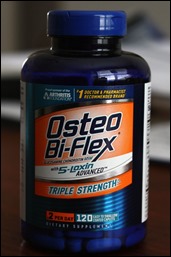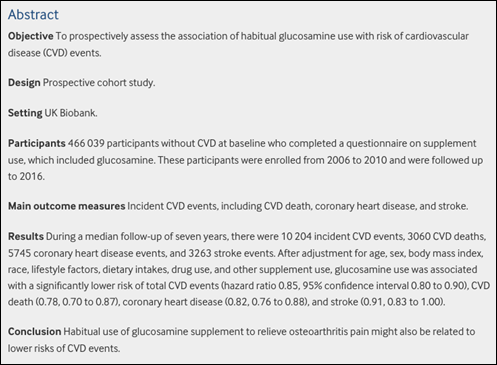Habitual glucosamine use and risk of CVD – UK Biobank study
Posted By RichC on June 4, 2019
One of the long running medical debates in my family is my use of a fairly expensive supplement called glucosamine. Ever since I injured my knee 15+ years ago and received what seemed like a miracle steroid injection – suffered for weeks — I’ve been more serious about taking better care of my joints. Aging and wear definitely takes a toll and after seeing an orthopedic surgeon, who reviewed my MRI, concluded that the only two treatments for my knees were: surgery to clean up the  joint or a knee replacement. Personally I’d like to avoid the knife so now constantly looks for ways to take care of the joints I have (you should too).
joint or a knee replacement. Personally I’d like to avoid the knife so now constantly looks for ways to take care of the joints I have (you should too).
What I “think” I have found for me is that avoiding excessive and repetitive weight loaded motion helps prevent swelling in the joints and that strengthening muscles supporting the knee helps; not abusing helps too. So keeping to that discipline and combined with light use of NSAIDs like Ibuprofen (Advil/Motrin/Aleve) to reduce pain and more importantly reduce inflammation after using my knees – I’ve been able to stay steroid injection free for over a decade. 
A few years ago, Drew my son-in-law, pointed me to the idea of Synvisc-One injections as a possible option. Supposedly one injection can provide OA knee pain relief by cushioning and lubricating knees … that makes sense and gives me another option.
But I have not had to look into anything further yet which brings me to the debated supplements for joints. I consistently take glucosamine to which most medical studies do not conclude as a recommended treatment option. One of the larger studies from overseas indicated that the results seemed about 50/50, but that those taking it “claim” it helped them (I’m in that camp). It may be likely that other things I do are helping and that I’m giving credit to the glucosamine supplement? Whichever it is, I continue to take it daily and remembering the discomfort I felt, refuse to give up taking it … as do about 20% of adults in countries where it is available without a prescription! (shocking)
Introduction
Glucosamine is a non-vitamin, non-mineral supplement widely used to relieve osteoarthritis and joint pain. Glucosamine is closely regulated in most European countries, where it is only sold with a prescription. However, in other countries such as the United States and Australia, it is a popular dietary supplement and approximately 20% of adults consume it daily.The effectiveness of glucosamine in patients with osteoarthritis and joint pain continues to be debated. Emerging evidence from epidemiological studies suggests that glucosamine could have a role in preventing cardiovascular disease (CVD) and reducing mortality.
Which leads me to a March 14, 2019 The BMJ 7-year follow-up study from UK Biobank that look at participants taking glucosamine from 2006-2010 and Cardiovascular Disease risks. Although not conclusive without further long term testing, the findings are that those habitually taking glucosamine for osteoarthritis pain have a lower CVD risk. Looks like a win-win for me. HA!
Conclusions
Habitual use of glucosamine supplement to relieve osteoarthritis pain might also be related to lower risks of CVD events. Further clinical trials are needed to test this hypothesis.

Comments